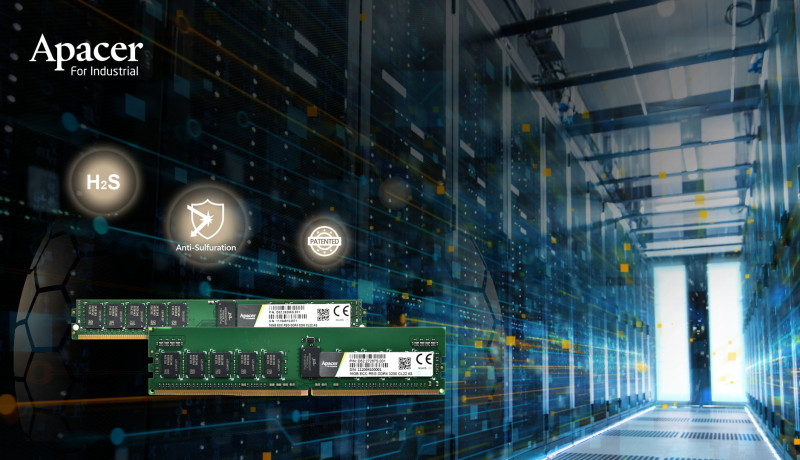Apacer’s DDR4 Anti-sulfuration Server Memory Provides The Highest Protection
April 21, 2020
on
on

Patented Technology Is a Breakthrough Advantage for Expanding Data Center Markets
The coronavirus-driven shift to working from home has meant rapid growth in the use of remote offices, remote learning and e-commerce. As a result, server memory is in great demand, thanks to the accelerated growth of data centers in many fields, from cloud computing to small- and medium-sized edge applications. But the challenge many new data centers are facing is pollution. Apacer, a leading industrial memory manufacturer, has leveraged its anti-sulfuration patent to launch server memory with the highest specifications of sulfur protection currently available. This DDR4 anti-sulfuration server memory stands apart from competitors in the market and will enhance the reliability of data centers.
In order to reduce the impact of pollutants in the air on the system availability of information appliances, large data centers have not only strictly implemented environmental control management, but also regulated indoor air quality by the highest standard of the International Society of Automation (ISA): 71.04-2013 G1. They also require that the relevant information equipment must have a considerable degree of anti-corrosion design to ensure that the server can run in the best operating conditions. And in recent years, these approaches have been adopted by small- and medium-sized data centers as well as edge server applications. Apacer created its high-spec DDR4 anti-sulfuration server memory to grab this market and provide a more value-added selection than is currently on offer from competing DRAM manufacturers.
Downtime accidents caused by environmental challenges have seriously affected the performance and reliability of data centers. The use of products with sulfur corrosion resistance can help increase the service life of the equipment, which is especially critical for data centers with high reliability requirements. According to Apacer’s analysis, most data centers in the past used standard server memory. But as anti-sulfuration memory gradually moves from niche applications to the mainstream market, data center business opportunities will continue to help popularize anti-sulfuration technology. Apacer has promoted its anti-sulfurization patent layout for many years, and has obtained anti-sulfurization memory module patents in the top two data center markets: the United States and China. This technology will become a tool to expand the global data center market.
Apacer’s anti-sulfuration server memory adopts the highest quality DRAM ICs from major manufacturers as well as anti-sulfur passive components. The gold finger plating thickness is up to 30u, which is the highest standard on the market. The maximum supported speed is an impressive 3200 MT/s. Apacer offers 4GB to 32GB capacity options and VLP (Very Low Profile) board sizes, and can meet the application needs of data centers, edge computing and netcom equipment from the cloud to the edge.
Find out about Apacer’s products for industrial applications at: https://industrial.apacer.com/
The coronavirus-driven shift to working from home has meant rapid growth in the use of remote offices, remote learning and e-commerce. As a result, server memory is in great demand, thanks to the accelerated growth of data centers in many fields, from cloud computing to small- and medium-sized edge applications. But the challenge many new data centers are facing is pollution. Apacer, a leading industrial memory manufacturer, has leveraged its anti-sulfuration patent to launch server memory with the highest specifications of sulfur protection currently available. This DDR4 anti-sulfuration server memory stands apart from competitors in the market and will enhance the reliability of data centers.
In order to reduce the impact of pollutants in the air on the system availability of information appliances, large data centers have not only strictly implemented environmental control management, but also regulated indoor air quality by the highest standard of the International Society of Automation (ISA): 71.04-2013 G1. They also require that the relevant information equipment must have a considerable degree of anti-corrosion design to ensure that the server can run in the best operating conditions. And in recent years, these approaches have been adopted by small- and medium-sized data centers as well as edge server applications. Apacer created its high-spec DDR4 anti-sulfuration server memory to grab this market and provide a more value-added selection than is currently on offer from competing DRAM manufacturers.
Downtime accidents caused by environmental challenges have seriously affected the performance and reliability of data centers. The use of products with sulfur corrosion resistance can help increase the service life of the equipment, which is especially critical for data centers with high reliability requirements. According to Apacer’s analysis, most data centers in the past used standard server memory. But as anti-sulfuration memory gradually moves from niche applications to the mainstream market, data center business opportunities will continue to help popularize anti-sulfuration technology. Apacer has promoted its anti-sulfurization patent layout for many years, and has obtained anti-sulfurization memory module patents in the top two data center markets: the United States and China. This technology will become a tool to expand the global data center market.
Apacer’s anti-sulfuration server memory adopts the highest quality DRAM ICs from major manufacturers as well as anti-sulfur passive components. The gold finger plating thickness is up to 30u, which is the highest standard on the market. The maximum supported speed is an impressive 3200 MT/s. Apacer offers 4GB to 32GB capacity options and VLP (Very Low Profile) board sizes, and can meet the application needs of data centers, edge computing and netcom equipment from the cloud to the edge.
Find out about Apacer’s products for industrial applications at: https://industrial.apacer.com/
Read full article
Hide full article



Discussion (0 comments)